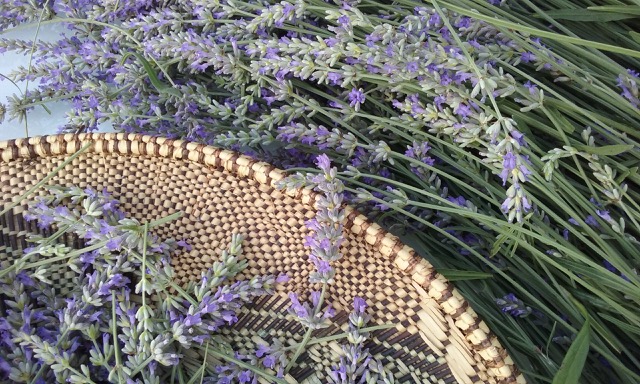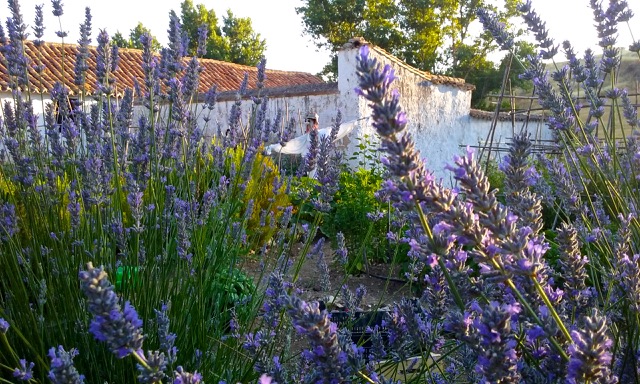 It is harvest time. That is to say, we are harvesting our lavender - all two plants of them. This may not seem like much, and it certainly wasn’t when we bought a couple of 1.50-euro pots three summers back. But things can certainly grow on these latitudes and the same plants are now giant bushes with a circumference of a couple of meters each. They might not be seen from space yet, but thanks to them, ours are decidedly the most eye-catching plot when you arrive at the community garden.
It is harvest time. That is to say, we are harvesting our lavender - all two plants of them. This may not seem like much, and it certainly wasn’t when we bought a couple of 1.50-euro pots three summers back. But things can certainly grow on these latitudes and the same plants are now giant bushes with a circumference of a couple of meters each. They might not be seen from space yet, but thanks to them, ours are decidedly the most eye-catching plot when you arrive at the community garden.
 Say the world lavender and people immediately think lavender fields in Provence or English gardens. Yet lavender is not native to England and Bulgaria actually overtook France as the world's biggest producer of lavender oil in 2011. Spain might not be amongst the top contestants when it comes to actual production, but while France has three species and two hybrids of lavender, the Iberian Peninsula has eleven species and subspecies and four wild hybrids, and twice as many if one counts the Canary Islands. France is still vital for the entire lavender industry, certainly in quality, innovation and marketing. Historically speaking, the plant was an important ingredient in France’s perfume industry, even if the most fragrant lavender is not the French Lavendila Dententa, but the Spanish Lavendula Stoechus.
Say the world lavender and people immediately think lavender fields in Provence or English gardens. Yet lavender is not native to England and Bulgaria actually overtook France as the world's biggest producer of lavender oil in 2011. Spain might not be amongst the top contestants when it comes to actual production, but while France has three species and two hybrids of lavender, the Iberian Peninsula has eleven species and subspecies and four wild hybrids, and twice as many if one counts the Canary Islands. France is still vital for the entire lavender industry, certainly in quality, innovation and marketing. Historically speaking, the plant was an important ingredient in France’s perfume industry, even if the most fragrant lavender is not the French Lavendila Dententa, but the Spanish Lavendula Stoechus.
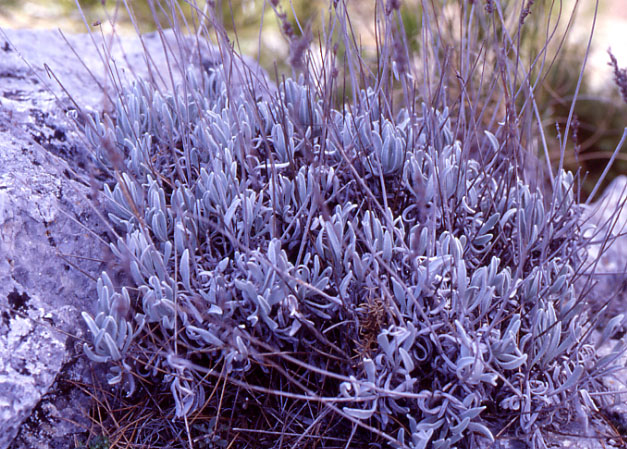 Originating in the coastal areas along the Mediterranean, lavender has been known for at least 2500 years and been acknowledged for its medicinal properties since the Materia Medica was written in the 1st century. There are now said to be some 115 varieties of the plant growing in gardens virtually all around the globe. When I was young nobody could ever imagine that lavender would grow in Norway, yet be it due to global warming or creation of tougher hybrids, one can now see lavender in Scandinavian gardens. I suppose soon we will see new hybrids of Alaskan and Icelandic lavender, as well? Lavender loves the Andalucian hot sun and poor soil. For us living here, the wild lavender is a common site along country roads and hiking trails, especially during the spring months when they are in bloom. There are times when one literally can walk waitst high in the deep purple blooms. Particularly the endemic species, such as the Lavandula Lantana, commonly known as Alhucema manage to grow from tiny gaps in the rock and be born out of the smallest patch of sandy soil.
Originating in the coastal areas along the Mediterranean, lavender has been known for at least 2500 years and been acknowledged for its medicinal properties since the Materia Medica was written in the 1st century. There are now said to be some 115 varieties of the plant growing in gardens virtually all around the globe. When I was young nobody could ever imagine that lavender would grow in Norway, yet be it due to global warming or creation of tougher hybrids, one can now see lavender in Scandinavian gardens. I suppose soon we will see new hybrids of Alaskan and Icelandic lavender, as well? Lavender loves the Andalucian hot sun and poor soil. For us living here, the wild lavender is a common site along country roads and hiking trails, especially during the spring months when they are in bloom. There are times when one literally can walk waitst high in the deep purple blooms. Particularly the endemic species, such as the Lavandula Lantana, commonly known as Alhucema manage to grow from tiny gaps in the rock and be born out of the smallest patch of sandy soil.
 Lavender comes from the Latin word lavandula, derived from the Latin verb lavare, meaning to wash. It is said to be because the Romans used lavender amongst other things to scent their bathwater. The plant was used during many plagues to disinfect homes and hospitals or burned to keep away bad smells, which were thought to attracted diseases.
Lavender comes from the Latin word lavandula, derived from the Latin verb lavare, meaning to wash. It is said to be because the Romans used lavender amongst other things to scent their bathwater. The plant was used during many plagues to disinfect homes and hospitals or burned to keep away bad smells, which were thought to attracted diseases.
So, what can you do with it with lavender, other than making sachets for your lingerie? Not only is it beautiful, but it has literally hundreds of uses. Lavender is antibacterial, antimicrobial, expectorant, stress relieving, antiseptic and analgesic, for those who know what all that means. Essential lavender oil can be used to protect against airborne viruses and bacteria, relieve menstrual cramps, deter moths & silverfish, calm coughs and colds, promote relaxation and sleep, sooth sunburns or other smaller burns, as a dandruff remedy, to relax sore muscles, for headaches, as a skin toner, for acne or skin irritations or as a natural air freshener. It can be used in baking, gourmet cooking, salads or teas. One can make lavender soaps, creams, talc, body butters, potions, lotions, bath bombs, scented oils, wreaths, candles, room sprays, carpet deodorizer or dryer sheets, just to mention a few.
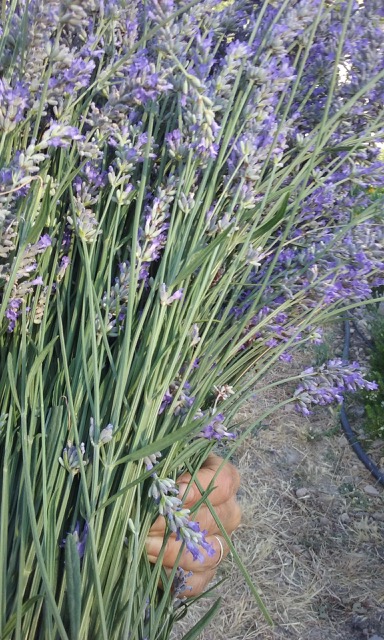 The lavender harvest should happen when the flowers are at their most stunning, or so my aunt who grows them in Tuscany told me. And aunts know such stuff. Other information sources tell one to pick them when 2/3 of the blooms are open, or was it 1/3? Anyhow, we pick a bit each day, cut off part of the stem and dry them in a large flat Zambian basket on the terrace, ideally away from direct sunlight. Once dried, you can easily pull the lavender flowers off the stem, going with the direction of the straw, or in stubborn cases, against it. Your hands will be black in the end, but will smell ever so lovely.
The lavender harvest should happen when the flowers are at their most stunning, or so my aunt who grows them in Tuscany told me. And aunts know such stuff. Other information sources tell one to pick them when 2/3 of the blooms are open, or was it 1/3? Anyhow, we pick a bit each day, cut off part of the stem and dry them in a large flat Zambian basket on the terrace, ideally away from direct sunlight. Once dried, you can easily pull the lavender flowers off the stem, going with the direction of the straw, or in stubborn cases, against it. Your hands will be black in the end, but will smell ever so lovely.
If I understand right, the production ratio for lavender oil is 100/1, meaning 100 kilos of blooms to one kilo of oil, so I am not planning to become commercial lavender producer just yet…To me, the greatest joy of growing lavender is simply having them there. To walk along the plants, letting ones hand touch the top of the flowers to release its heavenly scent.
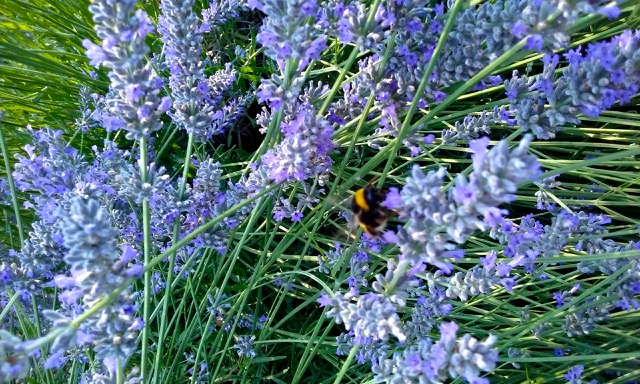 I never thought in my life I would virtually drown in lavender, but this is what I do these days, diving nose deep into the bushes, of course watching out for the other critters that also enjoy them. The bees, that most threatened species, love our huerto and all the flowering herbs there, lavender being their favourite. That should be reason enough to grow it, as heaven knows and we all know that the world needs more bees. The bees and I have come to a mutual understanding of shared enjoyment. I let them buzz about the plants and enjoy its bounty and they let me crop away, simply flying over to a different sprig to get out of the way.
I never thought in my life I would virtually drown in lavender, but this is what I do these days, diving nose deep into the bushes, of course watching out for the other critters that also enjoy them. The bees, that most threatened species, love our huerto and all the flowering herbs there, lavender being their favourite. That should be reason enough to grow it, as heaven knows and we all know that the world needs more bees. The bees and I have come to a mutual understanding of shared enjoyment. I let them buzz about the plants and enjoy its bounty and they let me crop away, simply flying over to a different sprig to get out of the way.
Every day I harvest an armful, leaving a trail of scented straws as we climb up from our huerto, maybe surprising a neighbour or friend with a generous bouquet and filling every vase in the house with freshly cut blooms. There is enough for everybody, para dar y prestar. (To give away and lend) as they say here in Andalucia.
